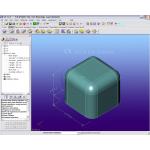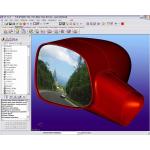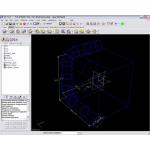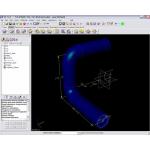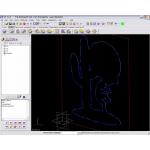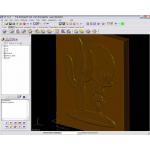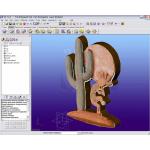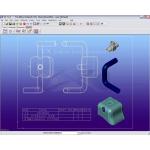Latest News
June 1, 2006
By Mike Hudspeth
Watch the quiet ones. They’re the ones who sit in class and don’t say much, but on test day they’ve got all the answers. They’re the ones who show up at class reunions as owners or CEOs of multibillion-dollar companies. The software world is like that. Some companies make a lot of noise but deliver hot air. Others, like VX Corporation of Palm Bay, FL, deliver the goods. Never heard of VX? Read on so you don’t miss out.
Choices, Choices
VX Version 12 is the company’s latest update of 3D modeling software covering a wide range of functionality in a handful of specialty bundles: VX Mechanical, VX Modeler, VX Designer, VX Mold & Die, and VX Machinist. There is also an uber-bundle called VX End-to-End that includes everything.
|
|
| VX Version 12 from VX Corp. |
› › Figure 1: When you are modeling in VX Version 12 you can make changes to your features the same way you would change a sketch.
VX Mechanical is the entry-level package. It has basic solid and assembly modeling plus drafting. VX Modeler allows you to build your design. It is aimed at industrial and product designers, and includes VX’s surfacing and NURBS tools. VX Designer lets you do something with your models (i.e., assemblies, drafting). It has all the advanced modeling and surfacing tools plus assembly capabilities. It also includes other modules like healing (for those times when you inherit someone else’s models and they aren’t quite watertight), PDM, rendering, and macros. VX Mold & Die helps you create accurate tooling models and VX Machinist brings CAM functionality to the table. It includes milling, hole making, verification, postprocessing, and format exchange.
|
|
| VX Version 12 from VX Corp. |
‹ ‹ Figure 2: VX Version 12 can create transitions from any shape to any shape, regardless of the number of segments. Here you can see VX go from a square shape to a triangular shape with no problem whatsoever.
One refreshing thing about VX Version 12 is that it gives you unlimited Undos and Redos. That’s a nice benefit when compared to other big-name 3D modelers that limit your Undos, meaning what you want to get back to is usually a few more steps back. Others don’t even have Redos.
Redos are just as important as Undos. It’s far too easy to go too far back and then find that you have to recreate stuff all over again. How efficient is that? VX Version 12’s Undos are really fast because they don’t have to rebuild the entire model, just what changed.
Modeling Made Easy
One of VX Version 12’s more interesting tricks is its feature modeling. You can model and then edit the feature just like a sketch. The creation parameters are available right on screen. It’s like solid sketching (see Figure 1, above) and it makes things much more straightforward. You see what is what and where. You can model with primitives as well as sketching. VX sketches will infer relationships according to the default settings you establish, thereby conforming to dimensions. Of course, they’re not always what you want because of those rigid settings, but you can constrain them any way you’d like. VX Version 12 lets you go back and forth between sheets and solids. It makes no distinction. It’s all the same hybrid geometry. You can even change between Booleans on the fly. If you put in a subtract, then later find you need an add, it’s no big deal. Just access the feature and flip a different switch on the menu.
|
|
| VX Version 12 from VX Corp. |
|
|
| VX Version 12 from VX Corp. |
Figure 3 (left): Using the edges of a solid saves a lot of time over creating a 3D sketch. Figure 4 (right): When you sweep your solid along the solid edges, then erase the solid, you still have the solid’s parameters for editing. Click images to enlarge.
VX Version 12 allows you to do a great deal with your models. You can morph your model into the exact shape you want. Pick an edge and tell VX to bump it out and then control how the morph affects the rest of the model. You can select edges, faces, and discrete points on your model. In most modelers, if you want to transition from a circle to a square you need to break the circle into four pieces. In VX you can morph any shape into another without worrying about the number of segments (see Figure 2, above). Crown allows you to control various parameters. Intelligent Surface allows you to create a three-surface fillet. It will use solid faces, sheet surfaces, even wireframe geometry with which to constrain the fillet.
I recently saw an interesting modeling technique to build a hydraulic tube. The modeler used VX 12 to build a cube and blended two corners. He then swept his tube around the edges of the cube, effectively making it a 3D sketch. He then used the erase command to ditch the cube. But because the erase in VX is a feature, the dimensions of the cube remained available for editing later (see Figures 3 and 4, above).
|
|
| VX Version 12 from VX Corp. |
|
|
| VX Version 12 from VX Corp. |
Figure 5 (left): VX Version 12 has a raster-to-vector converter. Just import a bitmap image into VX and trace it to form a profile. Figure 6 (right): VX Version 12 can emboss a bitmap image right onto your model. This adds detail that would otherwise be difficult or impossible to have. Click images to enlarge.
Raster to 3D
When the boss comes to you and says he wants you to model something and all he has is a picture ripped from a magazine, what do you do? If you have VX Version 12—no problem. VX comes with powerful raster-to-vector capability. You just scan the image and import it into VX. Then, you trace it into a profile (see Figure 5, above). You can use the profile for creating any kind of model you want. You can apply images to faces without going to high-end rendering, and it’s dynamic. When you rotate the model, the image updates in real time. You can use the image to emboss a texture onto your model (see Figure 6, above). VX uses light and dark values to tell it what is high or low. Darker values are lower and lighter values are higher. You control how high or low the values will be (see Figure 7, below).
|
|
| VX Version 12 from VX Corp. |
‹ ‹ Figure 7: Using the traced profile you can create a little piece of art. In this case Kokopelli, a Mayan god of song and dance leading to romance.
Last but not least, VX Version 12 has some effective drafting capabilities. For example, in most other systems, if you want to put different parts on the same drawing, you have to either create an assembly or import all the parts into one file. You have to put everything on different layers, then turn on the appropriate layers in the drawing views. A lot of work, to be sure. VX lets you bring in parts from other files (see Figure 8, bottom left) without all that fuss.
Direct, Effective Support
There are very few 3D modeling products on the market that cover as wide a range of functionality as VX Version 12. Of them, the others license or buy and roll in other vendors’ software. VX programmers write most of their code from scratch. That means when you have a problem you can usually get in touch with the person who wrote the program. That kind of direct support is refreshing nowadays.
|
|
| VX Version 12 from VX Corp. |
› › Figure 8: VX Version 12 allows you to place multiple parts from different files all on one drawing without working with assemblies.
You’ll be hard pressed to find a much better product than this one from VX. If you haven’t taken a look and gotten hooked, you should. It’ll be worth your time.
Mike Hudspeth is a senior designer for a global medical company and has been using a wide range of CAD products for 20 years. He, his wife, two daughters, and their cats live outside of St. Louis, MO. You can send him an e-mail about this article by clicking here. Please reference “VX 12, July 2006” in your message.
Product Information
VX 12
VX Corporation
Palm Bay, FL
Pricing:
VX Mechanical—$2,000, $500*
VX Modeler—$2,000, $500*
VX Designer—$4,000, $1,000*
VX Mold & Die—$6,000, $1,200*
VX Machinist—$6,000, $1,200*
VX End-to-End—$10,000, $2,000*
*annual maintenance costs
Subscribe to our FREE magazine, FREE email newsletters or both!
Latest News







